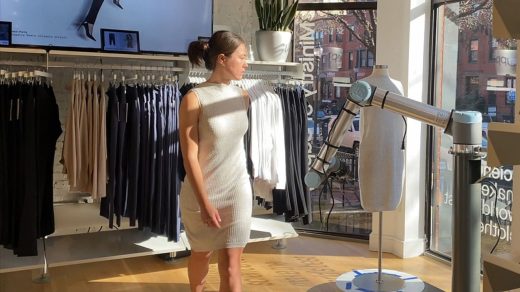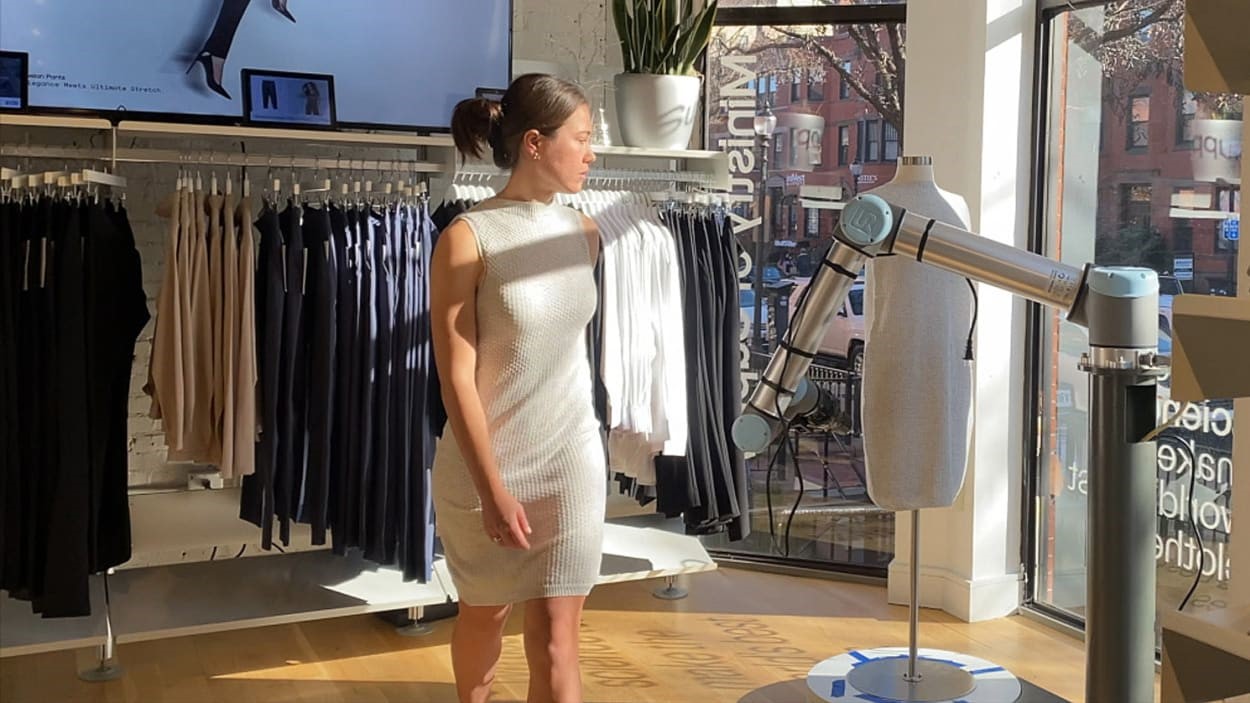The secret behind this shape-shifting dress? Heat-sensitive yarn
On a weekend morning in December, dozens of customers at Ministry of Supply’s flagship store in Boston crowded around a robot arm holding a heat gun. The customized robot, which costs roughly $30,000, was there to showcase the clothing company’s newest iteration of its 4D knit line—a dress that changes shape and style when exposed to high temperatures.
The grey, sleeveless garment’s initial form looks like a baggy, loose-fitting shift dress and can be worn as-is. But its shape serves as a blank canvas for the dress to transform into a multitude of other styles. For example, a customer who walks into Ministry of Supply in search of an A-line dress can watch the heating gun tighten the fabric around the torso, allowing the skirt to appear wider and the dress to take on a more triangular shape—all in real time.
Ministry of Supply partnered with MIT’s Self-Assembly Lab to develop the dress, with the help of a $1 million grant from Advanced Functional Fabrics of America. The clothing store and lab’s partnership dates back to the 2017 launch of their Active Textiles project, which developed a heat activated sweater in 2018 and 3D printed masks during the early days of COVID-19.
The sweater, however, “wasn’t comfortable,” says Gihan Amarasiriwardena, cofounder and president of Ministry of Supply. “No one wanted to wear it. It wasn’t efficient. And the other part was it wasn’t convenient; people couldn’t wash the products.”
Most of the innovation that Ministry of Supply and the Self-Assembly lab have worked on in the past five years has been related to the fabric’s feel and durability. Amarasiriwardena says the dress’s texture is often compared to cotton cashmere. To ensure that the garment is comfortable, the active yarn—the knitted material that responds to heat—is embedded within viscose yarn that Ministry of Supply already uses in many of its other products.
Viscose yarn is made from cellulose that has been extracted from wood pulp, which Amarasiriwardena says mimics Lego blocks that can be restructured to take on different properties, such as the ability to wick away moisture. “They have all the benefits of cotton, like they’re biodegradable, but we can get all the performance that we expect from our polyester,” he says.
The cleaning process has also been addressed. Skylar Tibbits, founder and co-director of the Self Assembly lab, said that when the sweater encountered high temperatures in a dryer, it triggered the yarn that knit the sweater together, shifting its shape and size. The team raised the dress’s activation temperature to 110 degrees Celsius, or 230 degrees Fahrenheit (dryers typically hover between 120 and 145 degrees Fahrenheit, depending on the heat setting).
While it may seem difficult to scale a product made with a giant—and expensive—robotic arm, Tibbits argues that if anything, the unique manufacturing process could lead to cost-cutting.
“It’s actually cheaper on that front because we only have to produce one [stock keeping unit]. We don’t have to produce every size,” he says. “You also have this experience where you come into the store, you can talk about how you want it to fit, you can talk about what kind of style you want, and then right before your eyes the dress can then be sculpted to be a dress that only you have, and no one else has.”
Currently, the 4D knit dress is being piloted by roughly 20 customers who bought a $500 store credit that they can use to either eventually purchase the dress or exchange for other Ministry of Supply apparel of an equivalent value, if they’d rather cash in on another product. Tibbits estimates that once commercialized, the dress will cost between $200 and $300, though “that likely could go down over time with [the] quantity of material ordered and optimized knitting times.”
Tibbits believes that the dress will appeal to consumers who struggle to find clothing in their size, who are on the hunt for something unique, or who are hoping to leave fast fashion behind.
“Clothing companies have to guess at what people want . . . and then you’re sitting on this huge inventory,” he says. “This directly addresses that, because you can have standard sizes, you can produce them on demand as needed, you can tailor them to the style choice of the customer or the season change.”
(10)



